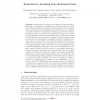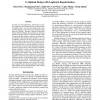292 search results - page 39 / 59 » Predicting labels for dyadic data |
MLDM
2007
Springer
14 years 4 months ago
2007
Springer
Transduction is an inference mechanism “from particular to particular”. Its application to classification tasks implies the use of both labeled (training) data and unlabeled (...
KDD
2008
ACM
14 years 10 months ago
2008
ACM
The input to an algorithm that learns a binary classifier normally consists of two sets of examples, where one set consists of positive examples of the concept to be learned, and ...
AAAI
2010
13 years 11 months ago
2010
In many real world applications, labeled data are usually expensive to get, while there may be a large amount of unlabeled data. To reduce the labeling cost, active learning attem...
BMCBI
2008
13 years 10 months ago
2008
Background: Alternative splicing is a major contributor to the diversity of eukaryotic transcriptomes and proteomes. Currently, large scale detection of alternative splicing using...
ICML
2004
IEEE
14 years 10 months ago
2004
IEEE
Kernel conditional random fields (KCRFs) are introduced as a framework for discriminative modeling of graph-structured data. A representer theorem for conditional graphical models...


